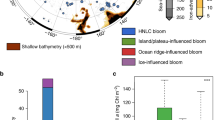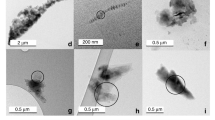Abstract
Hydrothermal vents emit sulphur and metals to the ocean1. Particular attention has been paid to hydrothermal fluxes of iron2,3,4, a limiting micronutrient of marine primary production5. Vent-derived iron was previously thought to rapidly oxidize and precipitate around vents6. However, organic matter can bind to and stabilize dissolved and particulate iron in hydrothermal plumes7,8,9, facilitating its dispersion into the open ocean10. Here, we report measurements of the chemical speciation of sulphide and iron in high-temperature fluids emanating from vents in the East Pacific Rise and the Eastern Lau Spreading Center. We show that pyrite nanoparticles—composed of iron and sulphur—account for up to 10% of the filterable iron (less than 200 nm in size) in these fluids. We suggest that these particles form before the discharge of the vent fluid. We estimate that pyrite nanoparticles sink more slowly than larger plume particles, and are more resistant to oxidation than dissolved Fe(II) and FeS. We suggest that the discharge of iron in the form of pyrite nanoparticles increases the probability that vent-derived iron will be transported over long distances in the deep ocean.
This is a preview of subscription content, access via your institution
Access options
Subscribe to this journal
Receive 12 print issues and online access
$259.00 per year
only $21.58 per issue
Buy this article
- Purchase on Springer Link
- Instant access to full article PDF
Prices may be subject to local taxes which are calculated during checkout



Similar content being viewed by others
References
German, C. R. & von Damm, K. L. Hydrothermal processes. Treatise Geochem. 6, 181–222 (2004).
Boyle, E. A. et al. Iron, manganese, and lead at Hawaii Ocean time-series station ALOHA: Temporal variability and an intermediate water hydrothermal plume. Geochim. Cosmochim. Acta 69, 933–952 (2005).
Bennett, S. A. et al. The distribution and stabilization of dissolved Fe in deep-sea hydrothermal plumes. Earth Planet. Sci. Lett. 270, 157–167 (2008).
Taglibue, A. et al. Hydrothermal contribution to the oceanic dissolved iron inventory. Nature Geosci. 3, 252–256 (2010).
Boyd, P. W. et al. Mesoscale iron enrichment experiments 1993–2005: Synthesis and future directions. Science 315, 612–617 (2007).
Mottl, M. J. & McConachy, T. F. Chemical processes in buoyant hydro-thermal plumes on the East Pacific Rise near 21° N. Geochim. Cosmochim. Acta 54, 1911–1927 (1990).
Statham, P. J., German, C. R. & Connelly, D. P. Iron(II) distribution and oxidation kinetics in hydrothermal plumes at the Kairei and Edmond vent sites, Indian Ocean. Earth Planet. Sci. Lett. 236, 588–596 (2005).
Schmidt, K., Koschinsky, A., Garbe-Schonberg, D., de Carvalho, L. M. & Seifert, R. Geochemistry of hydrothermal fluids from the ultramafic-hosted Logatchev hydrothermal field, 15° N on the Mid-Atlantic Ridge: Temporal and spatial investigation. Chem. Geol. 242, 1–21 (2007).
Toner, B. M. et al. Preservation of iron (II) by carbon-rich matrices in a hydrothermal plume. Nature Geosci. 2, 197–201 (2009).
Wu, J., Wells, M. L. & Remember, R. Dissolved iron anomaly in the deep tropical–subtropical Pacific: Evidence for long-range transport of hydrothermal iron. Geochim. Cosmochim. Acta 75, 460–468 (2011).
Elderfield, H. & Schultz, A. Mid-ocean ridge hydrothermal fluxes and the chemical composition of the ocean. Annu. Rev. Earth Planet. Sci. 24, 191–224 (1996).
Feely, R. A. et al. Composition and dissolution of black smoker particulates from active vents on the Juan de Fuca Ridge. J. Geophys. Res. 92, 11347–11363 (1987).
Field, M. P. & Sherrell, R. M. Dissolved and particulate Fe in a hydrothermal plume at 9° 45′ N, East Pacific Rise: Slow Fe(II) oxidation kinetics in Pacific plumes. Geochim. Cosmochim. Acta 64, 619–628 (2000).
Luther, G. W. et al. Chemical speciation drives hydrothermal vent ecology. Nature 410, 813–816 (2001).
Hsu-Kim, H., Mullaugh, K. M., Tsang, J. J., Yucel, M. & Luther, G. W. Formation of Zn- and Fe-sulphides near hydrothermal vents at the Eastern Lau Spreading Center: Implications for sulphide bioavailability to chemoautotrophs. Geochem. Trans., 9, 6 (2008).
Von Damm, K. L. in AGU Geophysical Monograph 144. The Subsurface Biosphere at Mid-Ocean Ridges (eds Wilcock, W. S. D., DeLong, E. F., Kelley, D. S., Baross, J. A. & Cary, S. C.) 245–268 (American Geophysical Union, 2004).
Von Damm, K. L. et al. Chemistry of submarine hydrothermal solutions at 21° N, East Pacific Rise. Geochim. Cosmochim. Acta 49, 2197–2220 (1985).
Fossing, H. & Jørgensen, B. B. Measurement of bacterial sulphate reduction in sediments: Evaluation of a single step chromium reduction method. Biogeochemistry 8, 205–222 (1989).
Stookey, L. L. Ferrozine—a new spectrophotometric reagent for iron. Anal. Chem. 42, 779–781 (1970).
Huerta-Diaz, M. A. & Morse, J. W. Pyritization of trace metals in anoxic marine sediments. Geochim. Cosmochim. Acta 56, 2681–2702 (1992).
Vaughan, D. J. & Craig, J. R. Mineral Chemistry of Metal Sulphides (Cambridge Univ. Press, 1978).
Morse, J. W. & Luther, G. W. Chemical influences on trace metal-sulphide interactions in anoxic sediments. Geochim. Cosmochim. Acta 63, 3373–3378 (1999).
Koski, R. A., Jonasson, R. I., Kadko, D., Smith, V. K. & Wong, F. L. Compositions, growth mechanisms, and temporal relations of hydrothermal sulphide–sulphate–silica chimneys at the northern Cleft segment, Juan de Fuca Ridge. J. Geophys. Res 99, 4813–4832 (1994).
Tivey, M. K. The influence of hydrothermal fluid composition and advection rates on black smoker chimney mineralogy: Insights from modeling transport and reaction. Geochim. Cosmochim. Acta 59, 1933–1949 (1995).
Rickard, D. T. Kinetics of pyrite formation by the H2S oxidation of iron (II) monosulphide in aqueous solutions between 25 and 125 °C: The rate equation. Geochim. Cosmochim. Acta 61, 115–134 (1997).
Rickard, D. T. & Luther, G. W. Kinetics of pyrite formation by the H2S oxidation of iron (II) monosulphide in aqueous solutions between 25 and 125 °C: The mechanism. Geochim. Cosmochim. Acta 61, 135–147 (1997).
Luther, G. W. & Rickard, D. T. Metal sulphide cluster complexes and their biogeochemical importance in the environment. J. Nanopart. Res. 7, 389–407 (2005).
Mullaugh, K. M. & Luther, G. W. Growth kinetics and long-term stability of CdS nanoparticles in aqueous solution under ambient conditions. J. Nanopart. Res. 13, 393–404 (2011).
Nicholson, R. V., Gillham, R. W. & Reardon, E. J. Pyrite oxidation in carbonate-buffered solution 2. Rate control by oxide coatings. Geochim. Cosmochim. Acta 54, 395–402 (1990).
Feely, R. et al. Composition and sedimentation of hydrothermal plume particles from North Cleft segment, Juan de Fuca Ridge. J. Geophys. Res. 99, 4985–5006 (1994).
Acknowledgements
This work was supported by grants to G.W.L. III from the National Science Foundation RIDGE program and the University of Delaware’s NSF EPSCoR program. A.G. acknowledges support from the Critical Zone research program funded by the University of Delaware. We thank E. Croker for assistance with SEM imaging, S. Modla for assistance with TEM imaging and C. Golt for assistance in ICP analyses.
Author information
Authors and Affiliations
Contributions
M.Y. and G.W.L. III designed the study. M.Y., A.G. and G.W.L. III performed sample collection and on-board processing. M.Y. performed sulphide and iron speciation analyses. A.G. performed other metal analyses and reaction kinetics calculations. C.S.C. performed TEM analysis of pyrite nanoparticles and contributed to data analysis. M.Y. and G.W.L. III drafted the manuscript. All authors contributed to interpretation of the results and editing of the manuscript.
Corresponding authors
Ethics declarations
Competing interests
The authors declare no competing financial interests.
Supplementary information
Supplementary Information
Supplementary Information (PDF 1526 kb)
Rights and permissions
About this article
Cite this article
Yücel, M., Gartman, A., Chan, C. et al. Hydrothermal vents as a kinetically stable source of iron-sulphide-bearing nanoparticles to the ocean. Nature Geosci 4, 367–371 (2011). https://doi.org/10.1038/ngeo1148
Received:
Accepted:
Published:
Issue Date:
DOI: https://doi.org/10.1038/ngeo1148
This article is cited by
-
Plants emit sulfate-, phosphate- and metal-containing nanoparticles
Environmental Chemistry Letters (2023)
-
Impacts of hydrothermal plume processes on oceanic metal cycles and transport
Nature Geoscience (2020)
-
Experimental Study on Nano-/Microparticles Transport to Characterize Structures in Fractured Porous Media
Rock Mechanics and Rock Engineering (2020)
-
Abiotic synthesis of graphite in hydrothermal vents
Nature Communications (2019)
-
Iron and sulfide nanoparticle formation and transport in nascent hydrothermal vent plumes
Nature Communications (2019)



